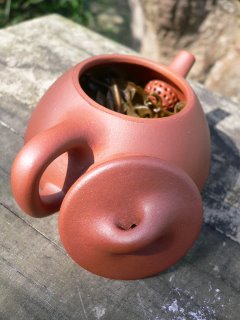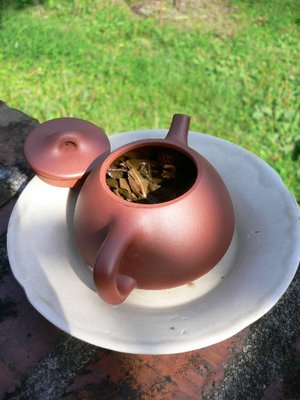
 This zisha (purple/brown) clay has a nice look of milk chocolate. The texture is a little sandy and you almost feel like wanting to bite it!
This zisha (purple/brown) clay has a nice look of milk chocolate. The texture is a little sandy and you almost feel like wanting to bite it! This handmade model comes with a gof ball shaped inside filter.
The flat triangle shape makes it a good teapot for non rolled leaves.
This pure zisha clay is medium to soft. Because it's pure, it's impacting the tea in a clean and clear way. Because the clay is a little soft, the pores are bigger and absorb quite a lot of fragrance and astringency.
My tests on greener Tie Guan Yin and on my 2003 raw wild Yiwu puerh have shown that such teas are not perfect for this pot. The lightest fragrances don't come out. On the other hand, I was delighted with the depth and mellow aftertaste. I then had an excellent result with my 1985 raw wild Yiwu Tuo Cha. This tea is very powerful and a little astringent in the first brews: this teapot handled it very well and rounded the angles while preserving the strong cha qi.


 One characteristic of the Shi Piao is its big handle, very much part of the pot. This means that the handle will become quite hot when you pour hot water on the teapot during the infusion. I had to grab the end of the handle to avoid getting my fingers burnt while pouring the tea.
One characteristic of the Shi Piao is its big handle, very much part of the pot. This means that the handle will become quite hot when you pour hot water on the teapot during the infusion. I had to grab the end of the handle to avoid getting my fingers burnt while pouring the tea. I noticed a similar 'problem' with the top of the teapot: it is also very close to the body and doesn't diffuse heat as well as a small ball does. This doesn't mean that you will burn your fingers, but you will have to be careful how to hold the teapot when pouring. It was a little annoying, but I guess that with practice, I will learn to hold it correctly without thinking. It's like a new car, I need to get used to it.
I noticed a similar 'problem' with the top of the teapot: it is also very close to the body and doesn't diffuse heat as well as a small ball does. This doesn't mean that you will burn your fingers, but you will have to be careful how to hold the teapot when pouring. It was a little annoying, but I guess that with practice, I will learn to hold it correctly without thinking. It's like a new car, I need to get used to it.  The spout is big enough for a quick and clean pour. So, this means that it would also suit cooked puerh quite well. Another tea group I think would be good for this teapot are roasted Wu Yi Oolongs.
The spout is big enough for a quick and clean pour. So, this means that it would also suit cooked puerh quite well. Another tea group I think would be good for this teapot are roasted Wu Yi Oolongs.I hope you're also enjoying the look at my Xmas decoration! Red is the color of celebration in the West and in the East!
 (Price for this zisha Shi Piao is the same as my other small zisha teapots.)
(Price for this zisha Shi Piao is the same as my other small zisha teapots.)







8 comments:
Bonjour,
Je trouve cette théiere vraiment magnifique, je crois bien que je vais craquer !;)
Par contre, étant novice, je me demande si l'on peut boire des puerh dans cette théiere ?
D'ailleurs, petite question de novice, j'ai lu que la terre d'Yixing était disparu, la ressource ayant été épuisée, dès lors qu'en est il des théieres d'Yixing que l'on trouve aujourd'hui ?
Un grand merci pour ce blog, toujours très plaisant à lire
La glaise zisha d'Yixing est loin d'être épuisée. Ce sont certaines glaises particulièrement fines qui le sont plus ou moins. En fait, d'après ce que j'ai compris, si certaines glaises sont épuisés, c'est plutot car on ne prépare plus la glaise de façon traditionnelle en la laissant reposer sur des dizaines d'années. Maintenant, on utilise des machines modernes pour filtrer la glaise. Avantage: réduction des coûts, standardisation et qualité bonne. Inconvénient: un tel processus peut donner des 'Renault' ou des 'Mercedes', mais rarement des Rolls Royce.
Sinon oui, je pense que cette théière convient assez bien aux puerhs cuits ou aux crus d'un certain age (mais pas pour les meilleurs).
Si cette théière est faite dans la même terre que ta petite théière Zisha d'Yixing (http://teamasters.blogspot.com/2006/02/thire-zisha-dyixing.html), à ce compte-la je conseillerais ce nouveau modèle particulièrement pour préparer les Wulongs très torréfiés ou les vieux Wulongs précieux. J'utilise désormais exclusivement la mienne avec ces thés-là. Le rendu est remarquable, je trouve.
Concernant les terres épuisées, c'est vrai que c'est compliqué, je m'y perds moi-même !!!
La glaise est pratiquement la même. Mais ta théière est plus ronde et convient donc mieux aux Oolongs que celle-ci de forme plus plate. Elle convient mieux aux vieux baozhongs ou au Shou Cha.
Very beautiful! And I need to master that "quick and clean pour!" Any suggestions?
Steph,
For a quick pour, you need to select a teapot with a big enough spout. Also, don't turn the teapot at a 90 degrees angle right away. It would 'suffocate' the teapot and the pour would be interrupted.
what is the price of your "Yixing zisha Shi Piao Hu" as shown in your photos?
Please send me an e-mail, and I'll send you my price list.
stephane_erler at yahoo.com
Post a Comment